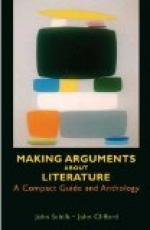We may now consider the evidence in favor of or against the three hypotheses. Let me first direct your attention to what is to be said about the hypothesis of the eternity of the state of things in which we now live. What will first strike you is, that it is a hypothesis which, whether true or false, is not capable of verification by any evidence. For, in order to obtain either circumstantial or testimonial evidence sufficient to prove the eternity of duration of the present state of nature, you must have an eternity of witnesses or an infinity of circumstances, and neither of these is attainable. It is utterly impossible that such evidence should be carried beyond a certain point of time; and all that could be said, at most, would be, that so far as the evidence could be traced, there was nothing to contradict the hypothesis. But when you look, not to the testimonial evidence—which, considering the relative insignificance of the antiquity of human records, might not be good for much in this case—but to the circumstantial evidence, then you will find that this hypothesis is absolutely incompatible with such evidence as we have; which is of so plain and so simple a character that it is impossible in any way to escape from the conclusions which it forces upon us.
You are, doubtless, all aware that the outer substance of the earth, which alone is accessible to direct observation, is not of a homogeneous character, but that it is made up of a number of layers or strata, the titles of the principal groups of which are placed upon the accompanying diagram.[68] Each of these groups represents a number of beds of sand, of stone, of clay, of slate, and of various other materials.
On careful examination, it is found that the materials of which each of these layers of more or less hard rock are composed are, for the most part, of the same nature as those which are at present being formed under known conditions on the surface of the earth. For example, the chalk, which constitutes a great part of the Cretaceous formation in some parts of the world, is practically identical in its physical and chemical characters with a substance which is now being formed at the bottom of the Atlantic Ocean, and covers an enormous area; other beds of rock are comparable with the sands which art; being formed upon seashores, packed together, and so on. Thus, omitting rocks of igneous origin, it is demonstrable that all these beds of stone, of which a total of not less than seventy thousand feet is known, have been formed by natural agencies, either out of the waste and washing of the dry land, or else by the accumulation of the exuviae of plants and animals. Many of these strata are full of such exuviae—the so-called “fossils.”




